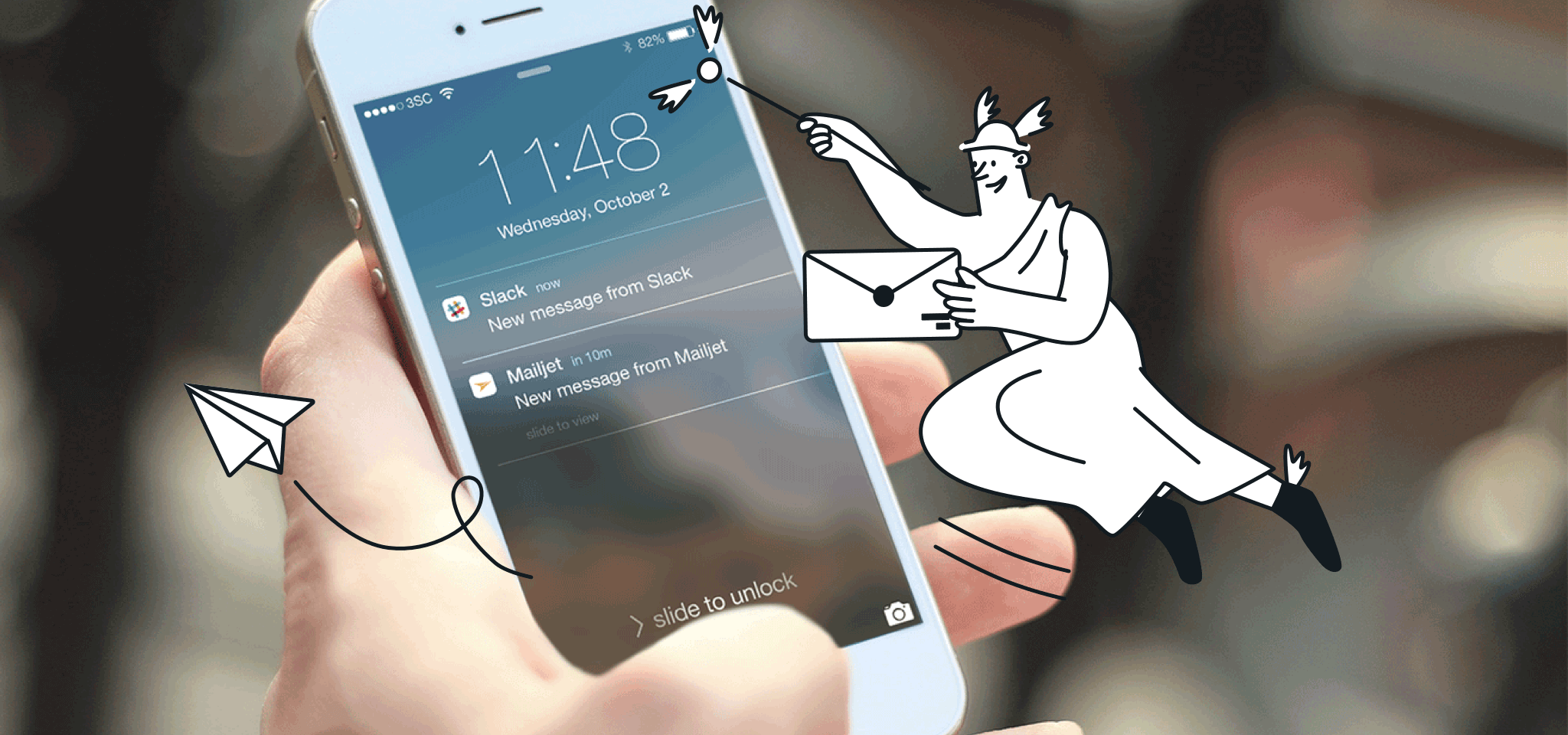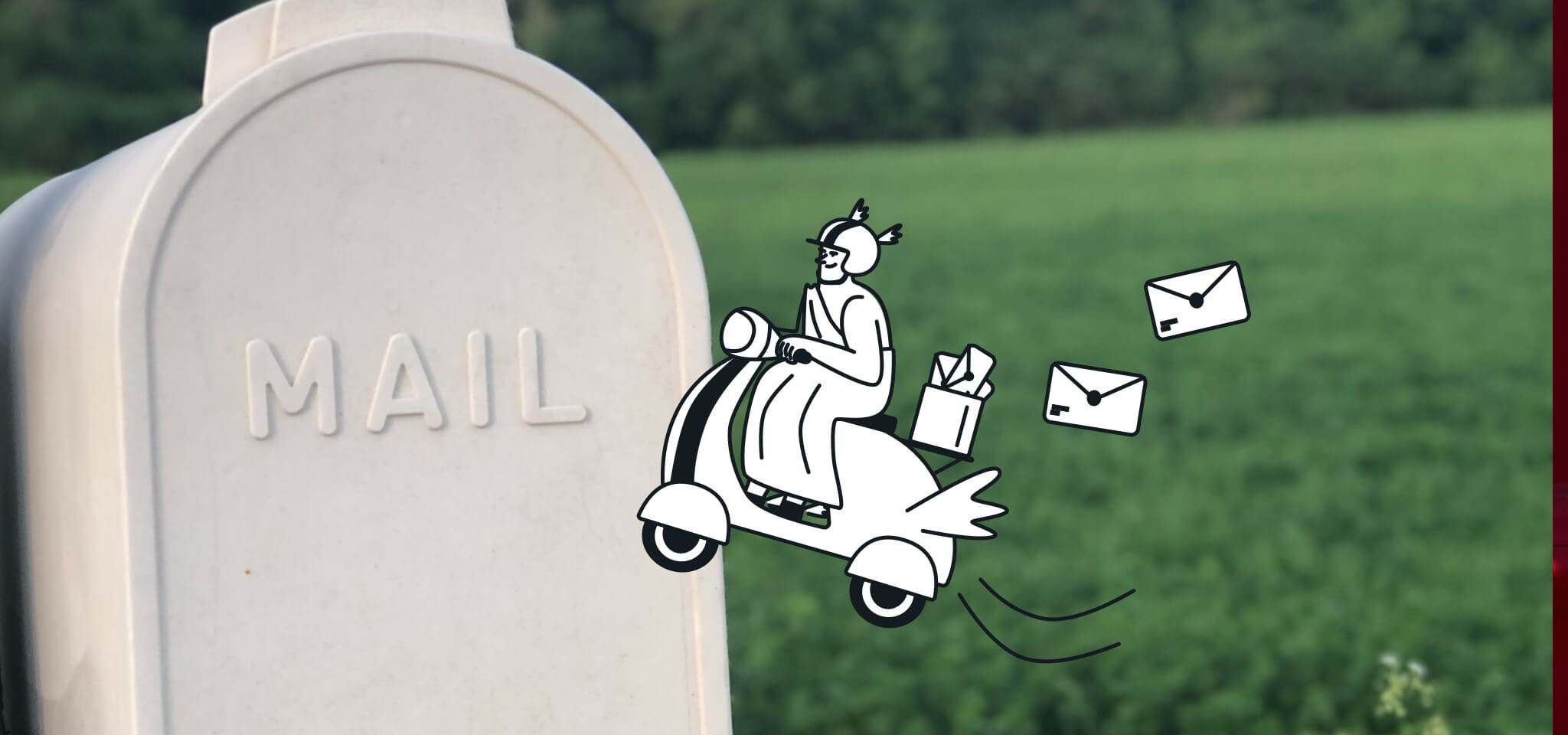Email best practices
How to get consumers to open more of your emails in 2024
Wondering how to get more email opens? It may be more than your subject lines that are the keys to success. Find out what a global survey of consumers reveals about increasing email engagement and get some tips to improve your open rates.

PUBLISHED ON
Email inboxes are jam-packed with promotional messages. There’s no way to avoid it. Every B2C brand on the planet would love to see their email open rates start skyrocketing, but is that realistic?
If you’ve been split testing subject lines and failing to find clear winners, there could be other (and dare we say it better) ways to increase your email open rate.
We decided to find out what consumers have to say. For our new report, The path to email engagement 2024, Sinch Mailjet surveyed more than 2,000 people from five countries. We wanted to learn about their habits and preferences around brand communications. That includes what convinces them to open and click on email marketing campaigns.
As you’ll see, it has to do with much more than just compelling subject lines.
Table of content
1. Recognizable sender/brand name
2. Offers in the subject lines
3. Personalized subject lines
4. Personalized email content
Email open rates: facing the challenges
We’ve all seen those astronomical statistics about the billions of emails being sent every day. But how many of those land in your customers’ inboxes and how many do they actually read?
The people who took our survey gave us an estimate of how many emails they tend to receive. 73% of consumers told us they get more than 10 emails on a typical day. But many get way more than that. 37.7% believe they get over 20 emails per day. That’s probably not surprising to you. In fact, people may be underestimating their totals.
However, the challenge comes with this next finding: 49.2% of consumers say they only open a few emails from brands per day and 8% won’t open any at all.
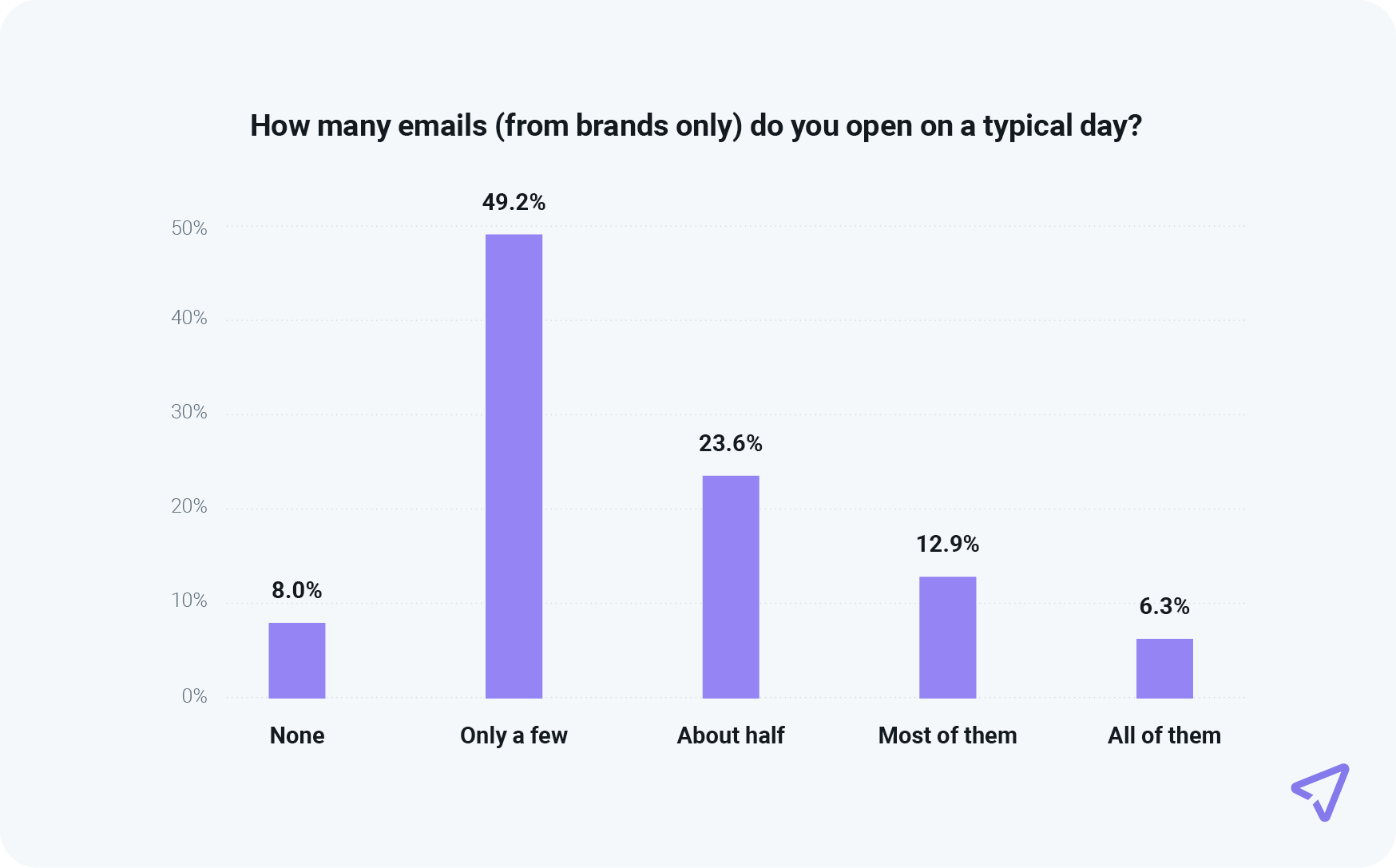
So, if you’re beating the average open rate for your industry, consider yourself one lucky email marketer.
The other problem with email open rates is the metric isn’t always seen as accurate and reliable. For example, tracking pixels used to measure email opens can get cut off if Gmail clips a message that’s too large. Apple Mail Privacy Protection preloads images, including tracking pixels, which can inflate open rates because the pixel fires before anyone views the message. Opens from people using Outlook may fail to register because the email client has images turned off by default. Email preview panes can also lead to inconsistencies in counting email opens.
That’s why many marketers now rely more on clicks and conversions to accurately measure email performance. But that doesn’t negate the fact that you still need to get people to open your emails. So, the best thing you can do is look at where the metric is today and figure out how to get more email opens tomorrow.
4 factors that impact email opens
Our survey asked consumers to rate the importance of several factors commonly associated with why people decide to open promotional emails. Let’s start with what people told us was most important.
1. Recognizable sender/brand name
You’ve been spending all this time crafting the perfect subject line, and it turns out the recognizability and reputation of your brand may be what convinces consumers to open your emails.
A combined 94.5% of survey respondents said recognizing the sender or brand name was either somewhat or very important when choosing whether to open an email. When consumers subscribe to your brand’s emails, it’s usually because they truly want to hear from you and learn more about what you offer. Your job is to deliver valuable, relevant email campaigns on a consistent basis.
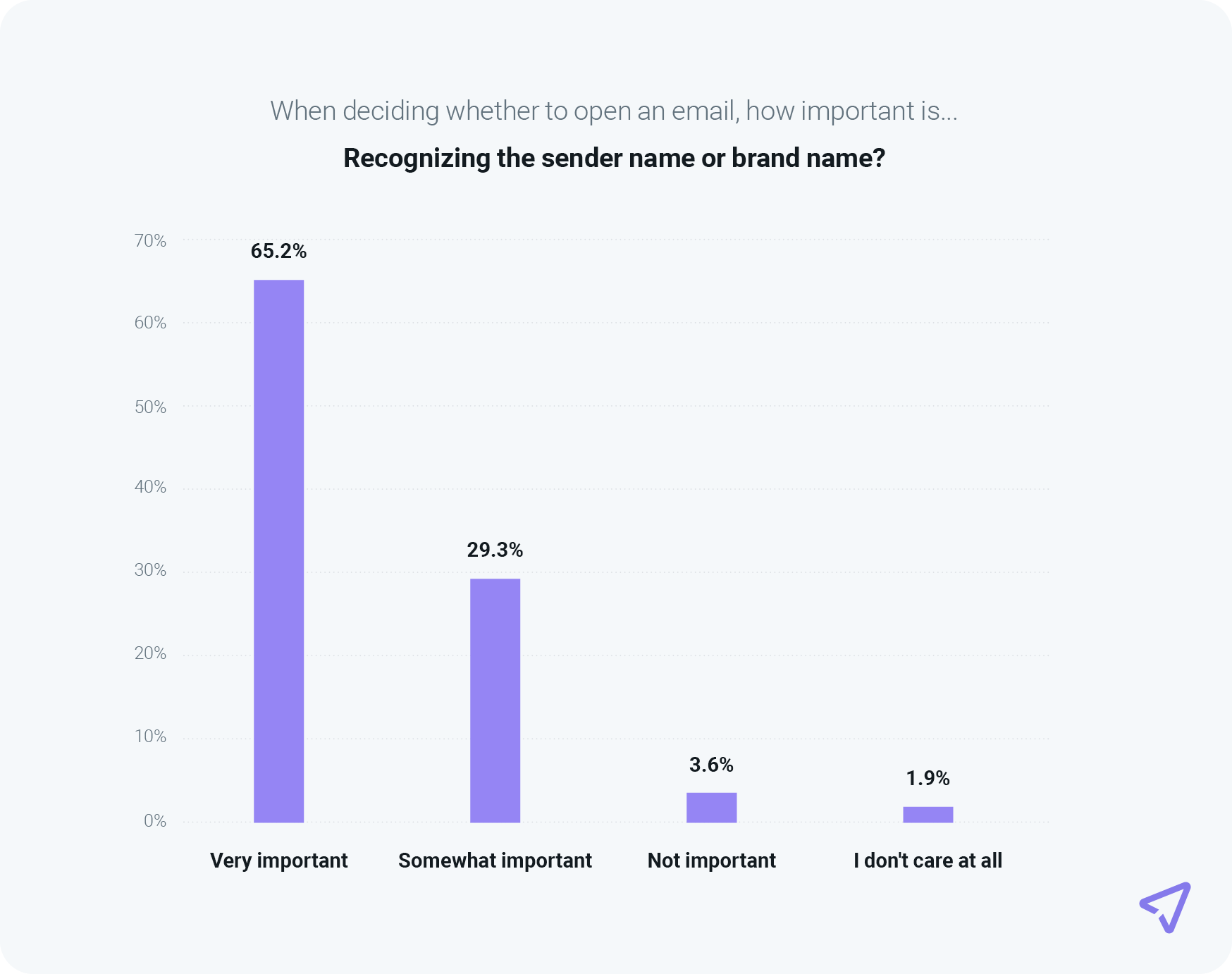
Sinch’s Sr. Email Developer, Megan Boshuyzen, ran her own informal poll on subject lines versus sender name. Her results were quite similar. 78% of respondents said they open emails based on the sender and only 22% chose the subject line.
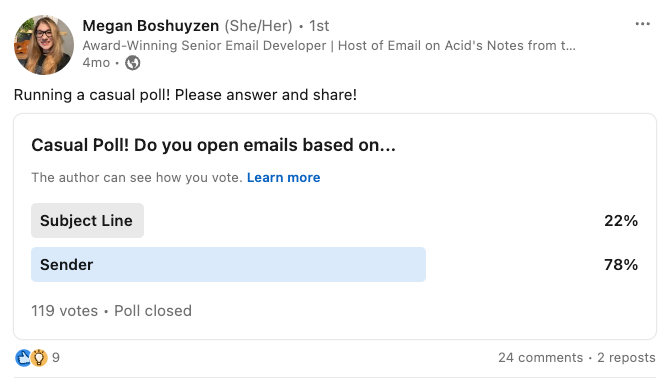
Spammers and scammers certainly know how convincing a recognizable brand can be. That's why email brand spoofing is such a problem. Bad actors impersonate brands to trick consumers into opening malicious messages. Thankfully, email authentication helps thwart those dirty deeds. Thats why Gmail and Yahoo’s new sender requirements in 2024 call for the use of all three protocols (SPF, DKIM, and DMARC).
Once you have email authentication in place, you may be eligible for what’s known as a BIMI logo. Senders who enforce a DMARC policy can have a verified logo show up next to messages in the inbox. If recognizing your brand as the sender name gets people to open, you’ve got to believe seeing a logo would do wonders for email engagement.

2. Offers in the subject lines
Clever copywriting will earn you some laughs, and emojis in subject lines may be eye-catching, but what consumers really want to know is how much you’re going to help them save.
When deciding if it’s worth their time to open an email, 78.7% of consumers say a discount or time-sensitive offer in the subject line is somewhat or very important. Money talks – as the saying goes. Looks like it’s also how to get more email opens.

Let’s be honest... Email newsletter designs and copywriting enhance the experience, but they’re called promotional emails for a reason. Our complete report on email engagement is full of findings that indicate consumers want to do just that – consume. These are the top three reasons survey respondents say they subscribe to a brand’s emails:
To regularly receive special offers (32.7%)
To get a one-time discount (23.6%)
To hear about the latest updates (15%)
62.8% of consumers say exclusive deals and offers are what they value most about emails from brands. Show them you’re delivering what they want by placing clear and compelling information on promotions directly in the subject line.
3. Personalized subject lines
Another popular tactic for increasing email open rates involves subject line personalization. Using a subscriber’s first name in the subject line is one of the most basic ways to deliver personalized emails. But does it work?
While seeing your name in a subject line may have a subconscious effect on opening emails, consumers seem less impressed by this factor. 61.2% of survey participants rated a name in the subject line as important. That’s the lowest of all four factors.
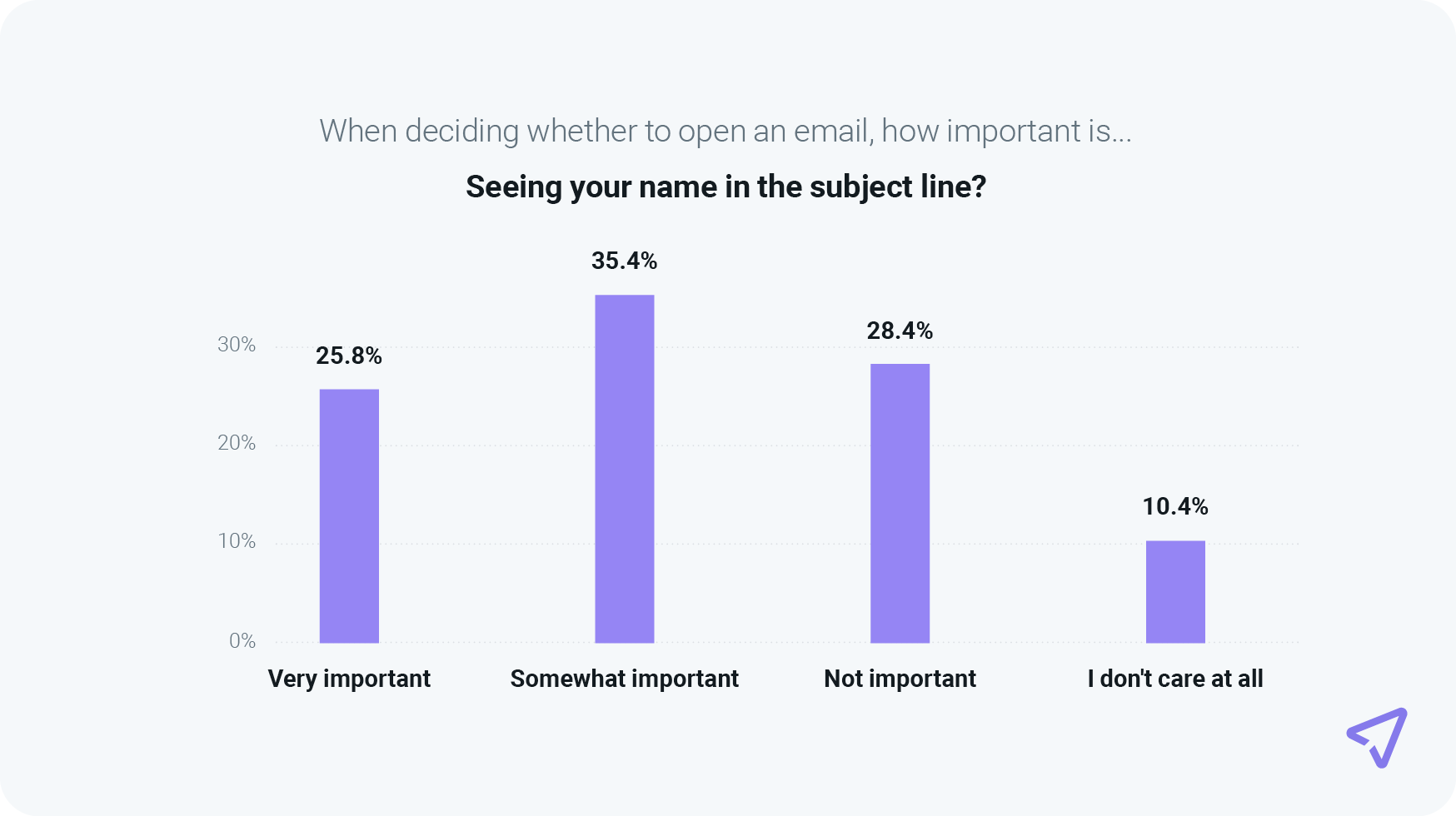
Personalized marketing has become so commonplace, it’s practically a consumer expectation. But how much does sticking a name in a subject line or greeting deliver a personalized experience? There are better, more advanced ways to use email personalization.
4. Personalized email content
A subject line almost always alludes to what’s inside the email. It entices customers and subscribers to open your email marketing campaigns. When it suggests there’s something inside that’s just for them, that could be the magic you need to get more email opens.
Our survey found 80.8% of consumers rate content that’s personalized to their interests as very or somewhat important when deciding whether to open an email. That “personalized content” might be offers based on demographics, recommended products based on past purchases, relevant articles or videos based on website behavior, and more.
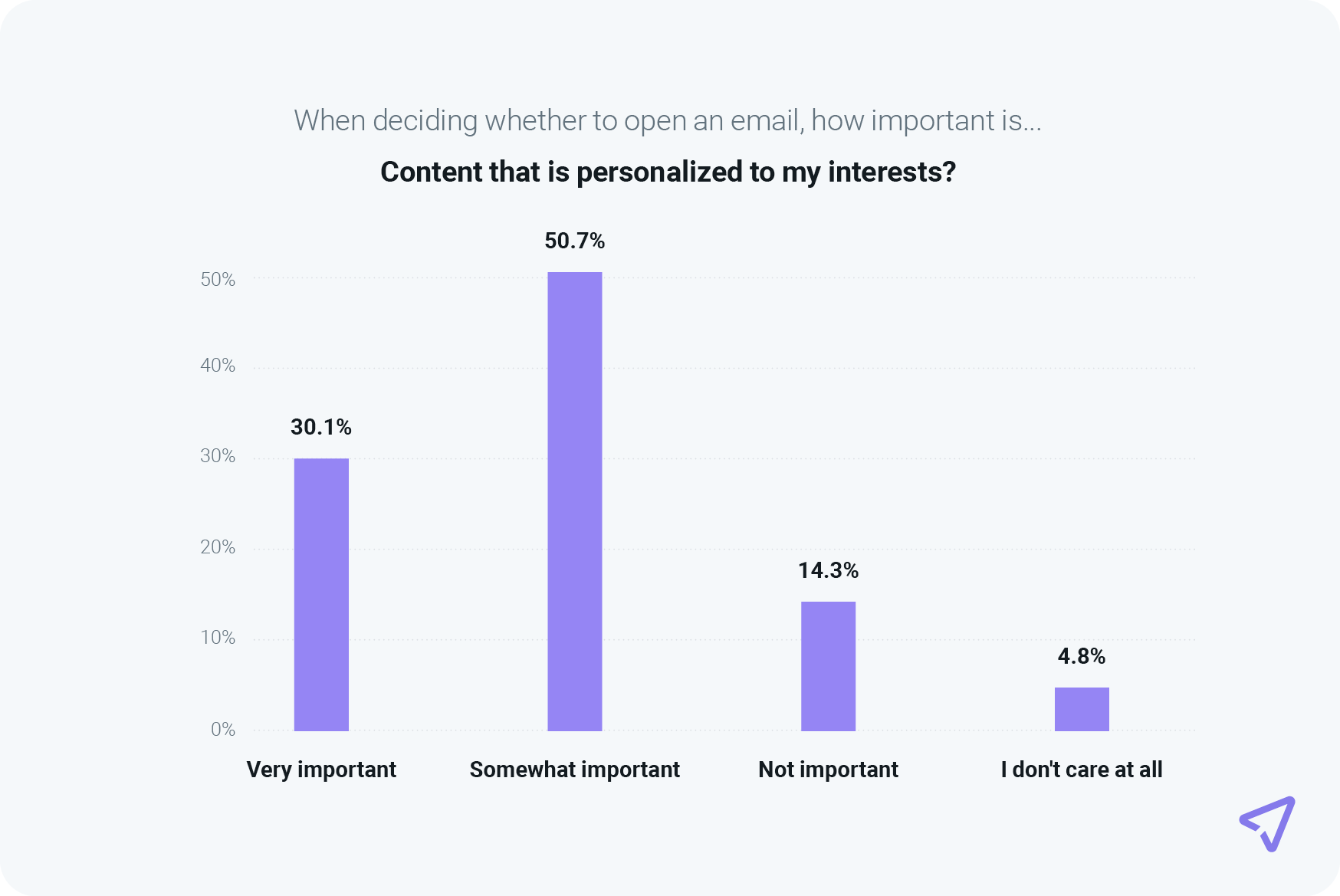
You could call out this kind of advanced personalization in a subject line, but the point is to deliver relevant email campaigns on a regular basis. Once consumers expect to receive promotional emails with personalized content, they’ll look forward to exploring the inbox experiences you deliver.
Think about ways to deliver emails that surprise and delight your customers and subscribers. Make them curious to see what they’ll discover the next time they open one of your email marketing campaigns.
More advanced personalization strategies help you stand out in those crowded inboxes. Sinch Mailjet’s Inbox Insights report found 46.5% of senders use names in email copy. But only around 27.5% personalize content and product recommendations.
Quick tips and best practices for better open rates
Beyond the four factors in our survey, there are plenty of other ways to optimize email campaigns for higher open rates. Here are a few reminders and suggestions:
Take advantage of preview text: Also known as preheader text, this is a bit of copy that appears next to the subject line at the inbox level. It’s an excellent way to complement the subject line with additional information, such as details on an offer. If you don’t define preheader text, most mailbox providers will display the first lines of email body copy.
Optimize for mobile: Our survey found more than 71% of consumers primarily view emails on their mobile phones. Your entire email should be responsive, while the subject line and preheader text should also be mobile-friendly. Keep in mind that too much copy will get truncated in mobile apps.
Segment your list and customize messages: You’ve segmented your list, but are you sending unique messaging, offers, or content to those specific groups? You’ll see the biggest impact from segmentation when you take the time to customize campaigns to match different needs, interests, and behaviors.
Split test subject lines: If results from A/B testing inbox display elements are often inconclusive, you may need to test more dramatic differences. Try completely different offers, emojis vs no emojis, funny vs straightforward, etc. The metric you choose to measure success is also important. Instead of opens, you may want to choose subject lines that generate the most clicks or conversions.
There’s one more reason why your open rates are lower than expected. You may need to conduct some email list hygiene. If your list contains invalid email addresses or contacts who haven’t engaged in months, remove them or segment those subscribers for a re-engagement campaign. Once unengaged and invalid contacts are gone, you’re likely to see a significant spike in open rates. List cleaning also makes the metric more accurate.
How Sinch Mailjet helps with email engagement
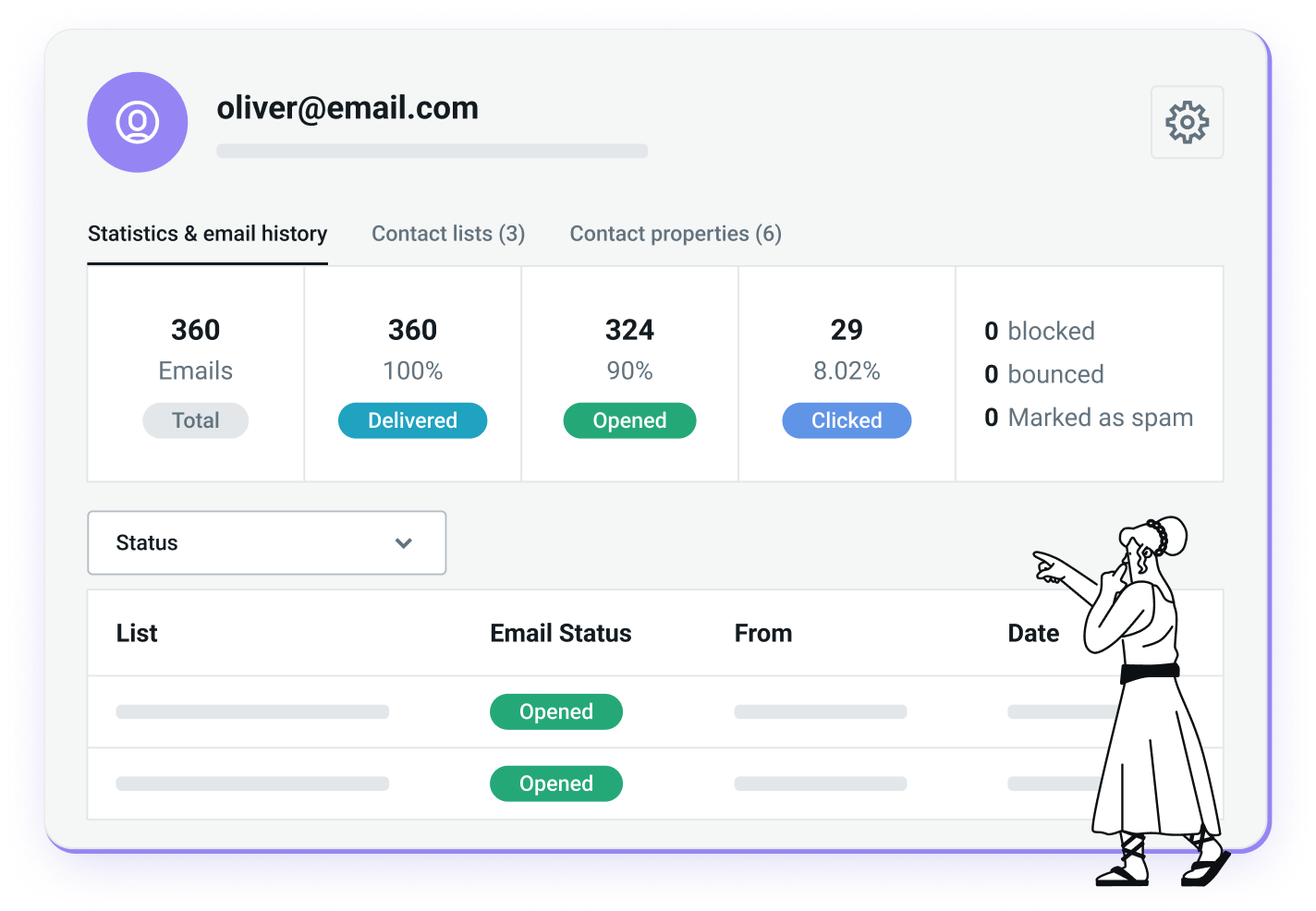
There are no shortcuts on the path to better email engagement. Here's the truth about how to get more email opens: It’s all about consistently using the channel to deliver messages that are useful, valuable, entertaining, and relevant to your subscribers.
Of course, every email marketer can use helpful tools to make the job of crafting engaging campaigns a little easier. Here are a few ways Sinch Mailjet users take advantage of our platform:
A/B testing features help senders optimize for better engagement. Test up to 10 different versions of a campaign at once and find out what’s most likely to make your subscribers respond.
Segmentation and personalization features let you send targeted campaigns based on a wide variety of contact attributes. For example, you can use engagement behaviors to determine the best way to communicate with different customer groups.
Mailjet’s AI Copy Generator is a useful tool when you need to brainstorm options for subject lines, email copy, calls to action, and more. Harness the power of artificial intelligence in marketing and tailor the tool for your brand voice and audience.
Finally, when you need to measure and analyze your results, Mailjet’s Statistics dashboard has all the metrics you need to discover actionable insights that improve your email program’s strategy.
You can start with Sinch Mailjet for free today. Give us a try and upgrade whenever you’re ready or as you grow to need additional features and support.



